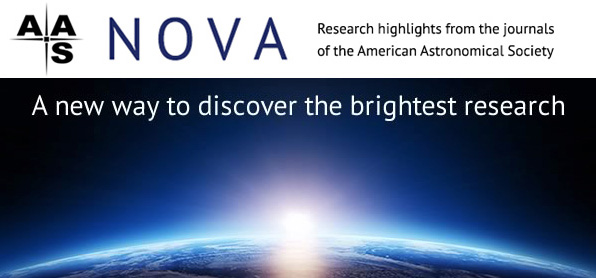Highlights from AAS Nova: 5-18 March 2017

Susanna Kohler American Astronomical Society (AAS)
AAS Nova provides brief highlights of recently published articles from the AAS journals, i.e., The Astronomical Journal (AJ) and The Astrophysical Journal (ApJ), ApJ Letters, and ApJ Supplements. The website's intent is to gain broader exposure for AAS authors and to provide astronomy researchers and enthusiasts with summaries of recent, interesting research across a wide range of astronomical fields.
The following are the AAS Nova highlights from the past two weeks; follow the links to read more, or visit the AAS Nova webpage for more posts.
17 March 2017
More Unusual Light Curves from Kepler
Twenty-three new objects have been added to the growing collection of stars that have unusual dips in their light curves.
15 March 2017
A Connection Between Corona and Jet
A new study provides us with clues to the relationship between accretion and outflows near the supermassive black holes at the centers of active galaxies.
14 March 2017
A Volcanic Hydrogen Habitable Zone
Astrobites reports on whether volcanos can expand the region around a star within which life can survive.
13 March 2017
How Stable is a Light Sail Riding on a Laser Beam?
The Breakthrough Starshot Initiative will send tiny spacecraft to our nearest stellar neighbors. A new study examines how we can successfully propel these spacecraft on their way.
10 March 2017
Building Magnetic Fields in White Dwarfs
Some white dwarfs have magnetic fields with strengths of thousands to billions of times that of Earth. A new study examines how these fields might form.
8 March 2017
The Discovery of Five Early Gamma-Ray Blazars
Software improvements have allowed the Fermi Gamma-ray Space Telescope to discover five gamma-ray blazars at high redshifts, opening a window to the early universe.
7 March 2017
Peeking Through the Haze: A Look at Titan’s Bright Surface Features
Astrobites reports on what we’re learning from the stunning maps of Titan made by the Visible and Infrared Mapping Spectrometer on board Cassini.
6 March 2017
Featured Image: Simulating Planetary Gaps
Can we use observations of gaps in protoplanetary disks to estimate the mass of planets orbiting within them?


